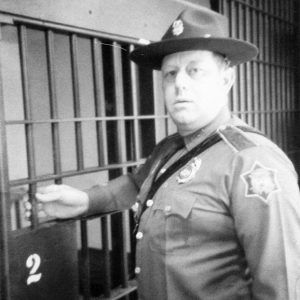calsfoundation@cals.org
Arkansas State Police
A division within the umbrella agency of the Arkansas Department of Public Safety (ADPS), the Arkansas State Police is the state’s primary statewide law enforcement agency. Although it has had many duties since its inception, the primary functions of the agency remain criminal investigation, traffic safety, and highway patrol. As a state agency, the State Police is overseen by a director bearing the rank of colonel who serves at the pleasure of the governor. The State Police’s main headquarters are located in Little Rock (Pulaski County), with the highway patrol organized into twelve regional “troops,” each commanded by a captain, and the criminal investigation division organized into six regional “companies,” each commanded by a lieutenant.
The creation of a centralized, statewide law enforcement agency in Arkansas proved to be a difficult process, as many state legislators worried that such a force would infringe upon the authority of local officers. Still, the rise in popularity of automobiles in the 1920s resulted in a corresponding increase in the number of fatal traffic accidents, which provided enough incentive for the establishment in 1929 of a precursor to the State Police, known as the Road Patrol.
By 1935, the continued rise in traffic fatalities combined with the need for a law enforcement agency to enforce newly enacted liquor laws after the legislature voted to end Prohibition in Arkansas. This new law enforcement agency was designated the Department of Arkansas State Police and consisted of thirteen officers of which seven were known as “rangers.” In an effort to appease the new agency’s opponents, state police officers could only be called to investigate a crime if specifically requested by local authorities.
By 1948, the force had expanded to more than sixty-five officers and included separate divisions for highway patrol and criminal investigation. That same year, the State Police began referring to its highway patrol officers as “troopers” for the first time. By 1957, the State Police had doubled in size following Governor Orval Faubus’s push to have “a trooper in every county.”
The ten-year period from 1965 to 1975 saw the greatest changes within the State Police. Marion Taylor became the first African American state police officer in 1967. Later that same year, Winthrop Rockefeller won election as the state’s first Republican governor since Reconstruction and vowed to remove politics from the agency. The clearest example of Governor Rockefeller’s intent occurred in Hot Springs (Garland County), where a multitude of casinos openly flouted the state’s gambling laws. During Rockefeller’s four years as governor, the State Police repeatedly and consistently cracked down on the casinos in Hot Springs. This effectively ended illegal gambling despite strong political pressure from powerful state legislators, including Garland County’s Q. Byrum Hurst and Conway County’s Guy Jones, to end the raids.
This heightened level of activity continued throughout the late 1960s and mid-1970s as troopers and investigators deployed throughout the state in an attempt to head off violence resulting from civil rights demonstrations. Incidents in Hazen (Prairie County), Little Rock, Forrest City (St. Francis County), Pine Bluff (Jefferson County), Marianna (Lee County), and Arkadelphia (Clark County) kept the department focused on keeping the peace instead of its traditional role patrolling the highways and investigating crimes. In 1968, following the assassination of Martin Luther King Jr., State Police officers were requested by the city of Memphis, Tennessee, and deputized as sheriff’s deputies to assist in bringing order back to the city when civil unrest erupted.
Also during this period, the State Police installed the first computerized automobile registration database, linked up with the national crime information center database, and hired its first female officer, Barbara Cart, in 1975.
In the 1980s and 1990s, the State Police expanded its efforts in drug enforcement by initializing an annual marijuana eradication program and establishing drug interdiction and canine units that worked the state’s interstate highway system. The department also benefited from the federal government’s Community Oriented Policing (COP) program started in 1994, which provided millions of dollars in federal grants that allowed the department to hire almost 100 additional officers.
By the start of the twenty-first century, the State Police had grown to almost 1,000 officers and civilian workers. Concurrently, the traffic fatality rate fell from twenty-four deaths per 100 million miles traveled in 1934 to two deaths per 100 million miles traveled in 2001.
As part of Act 910 of 2019, the agency was made a division of the newly created Arkansas Department of Public Safety (ADPS).
For additional information:
Arkansas State Police. https://asp.arkansas.gov/ (accessed December 15, 2025).
Arkansas State Police 85th Anniversary Yearbook, 1935–2020. Sikeston, MO: Acclaim Press, 2020.
Badges, Bandits, and Bars: Arkansas Law and Justice. Old State House Museum Online Collections. Law and Justice Collection (accessed December 15, 2025).
Bailey, John. Integrity on Patrol: 101 Stories of the Arkansas State Police. Kinsman, OH: Virginia Pines Press, 2002.
Lindsey, Michael G. The Big Hat Law: Arkansas and its State Police, 1935–2000. Arkansas State Police. Little Rock: Butler Center Books, 2008.
———. “Localism and Creation of a State Police in Arkansas.” Arkansas Historical Quarterly 64 (Winter 2005): 353–380.
Michael Lindsey
Fayetteville, Arkansas




















Comments
No comments on this entry yet.